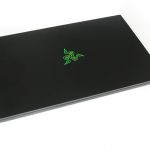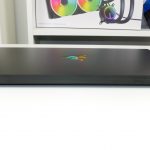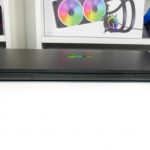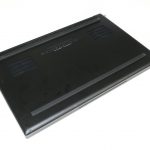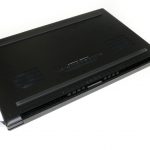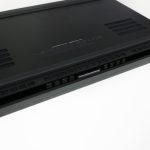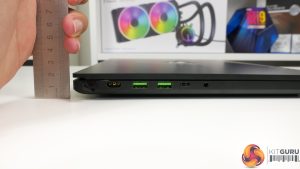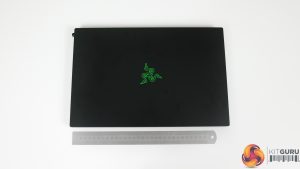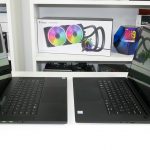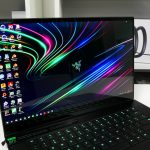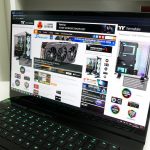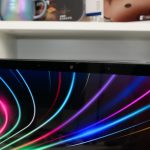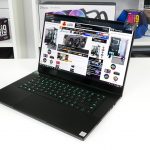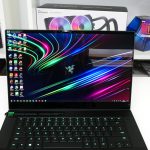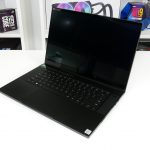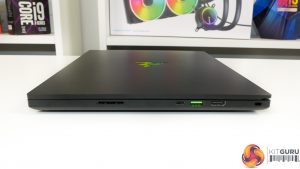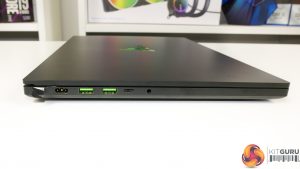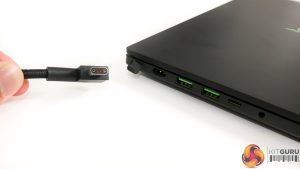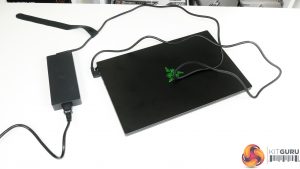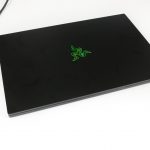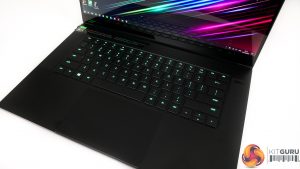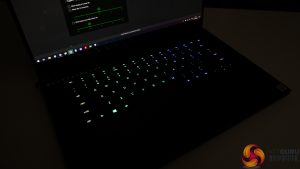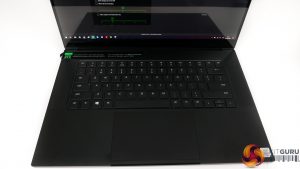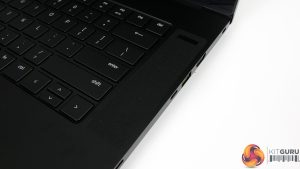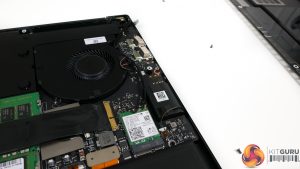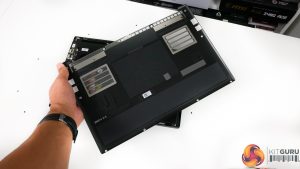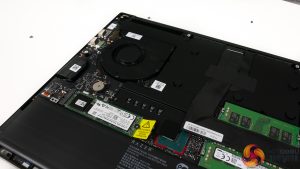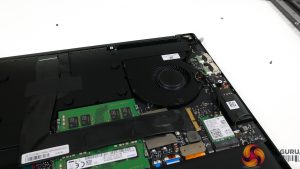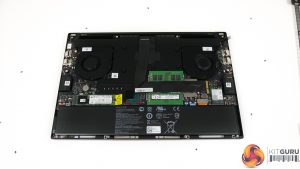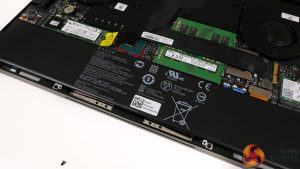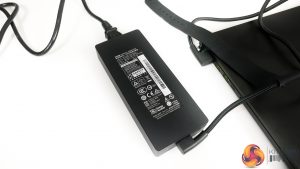Starting off with the design of the Razer Blade 15 Advanced, the slim aluminium unibody chassis gives the laptop a total weight of less than 2.2kg. ‘Premium’ is the first word that jumps to mind when handling the dark black laptop.
Despite its alluring appearance, stiffness and ruggedness score highly. That’s clearly important for such a sizable investment that will be moved from place to place by many users.
With the lid closed, the laptop is around 21mm thick. That figure drops by around 4-5mm with the lid open. And speaking of opening the lid, Razer has nailed the weight distribution and hinge design, thus allowing the one-finger lid open to work consistently.
The dimensions are very comparable to the Dell XPS 15 9570/7590 version. I would call that strong praise for the Razer as I personally feel that Dell’s XPS 15 design is superb, but Razer takes it up a notch by squeezing in higher-end hardware.
One area where Razer does not score particularly highly for the chassis design, however, is in terms of finish. While the aluminium looks and feels premium, it is a fingerprint magnet and quickly starts to look grubby after being touched even to a minimal degree. Thankfully, Razer includes a much-needed cloth.
The backlit Razer logo on the rear of the lid is a cool touch and it can be disabled via software, if you prefer.
Quality-wise, the factory calibrated 15.6” 4K 60Hz OLED touch display is wonderful. I am personally a fan of OLED displays, and Razer does nothing to disappoint my preference. 100% DCI-P3 colour coverage allows the items displayed on screen to pop with a strong vibrance, and I was happy with the peak brightness level.
Clearly 4K60 is going to be tough for laptop hardware to run in AAA gaming titles. Some users may prefer the alternative Full HD 300Hz option for high-FPS gaming. However, 4K60 on an OLED display is an excellent solution for productivity and dual-purpose use cases where the laptop is being used for more than simply gaming.
No doubt, the screen handles gaming very well from an image display perspective. But to get a solid 60FPS average frame rate, you will have to compromise on either the game’s image quality settings or render resolution.
Given the choice, though, I’d take a 4K60 OLED screen on a laptop of this ilk if I used it for more than just gaming.
Connectivity is a clear strength for the Blade 15 Advanced thanks to Razer’s well-thought set of inclusions.
On the right side, you get a 10Gbps USB 3.2 Gen 2 Type-A port, Thunderbolt 3 Type-C, HDMI 2.0b, a Kensington lock, and a full-sized UHS-III SD card reader. Thunderbolt 3 is a connection that I am particularly happy to see thanks to its flexibility with high-speed external GPU or dock and storage solutions, DisplayPort video output mode, and 20V PD 3.0 charging capability that Razer bakes in.
Moving around to the left side, you get the proprietary charging connection, another two 10Gbps USB 3.2 Gen 2 Type-A ports, 10Gbps USB 3.2 Gen 2 Type-C, and a 3.5mm combo audio jack. That Type-C port also supports DisplayPort video output and PD 3.0 charging capability, but not Thunderbolt 3.
I like the way that Razer spreads the Type-A ports meaning that chunky connectors will not block all Type-A ports on the laptop. Of course, that’s assuming that you orientate to reversible connector from the 230W power brick to not block the two left-sided Type-A ports.
The only clear omission in terms of connectivity is a Gigabit Ethernet jack. Given the limitations of the slim chassis design, I am personally fine with this compromise and would happily use a USB to Ethernet adapter as required. Plus, you get WiFi 6 and Bluetooth 5.1 through an Intel AX201 adapter that comfortably maxed out our 550Mbps Virgin fibre connection in our WiFi speed test.
One area where I was particularly impressed by the Blade 15 Advanced connection option was in terms of display outputs. The combination of HDMI 2.0 and two DisplayPort-capable Type-C connectors make powering three external high-resolution and high refresh rate monitors a possibility. We successfully tested this using monitors running simultaneously at 1080P 165Hz, 1440P 165Hz, and 4K 60Hz.
Aptly, Razer wires these three display outputs from the Nvidia GPU (which is not an obvious preference, given the XPS 15 7590 TB3 port’s wiring to the Intel iGPU). This permits for the powering of the aforementioned triple-monitor setup whilst maintaining the laptop screen that runs via the Intel iGPU.
What’s more, the Nvidia display connections permit for G-Sync on a compatible adaptive refresh rate monitor, as we tested with the Aorus FI27Q screen. Four total displays consisting of three external monitors, plus G-Sync capability to those bigger gaming screens, is an absolutely fantastic setup for a laptop. Even at the price point we are dealing with, it is not common for a gaming or workstation style laptop to offer such a high degree of display connectivity. Excellent job, Razer.
They keyboard is pleasant to type on thanks to the minimal flex enabled by the premium aluminium chassis. I would, however, have liked more travel for a better typing experience that was more comparable to my Dell XPS 15 preference. Nevertheless, Razer is certainly offering one of the better laptop keyboards that I have come across (as should be the case on a £3K+ machine!).
The small enter key is not ideal for productivity usage and did not fit my personal preference. However, it does allow for a larger right-side shift key and that is likely to please gamers, even if it does result in smaller arrow keys.
Razer’s Synapse software can perform gaming-orientated control functions for the keyboard, such as disabling the Windows key and Alt+F4 whilst gaming or all the time. It can also switch the preference between media keys or function keys being permanently set.
Razer Chroma RGB backlight on each individual key is smooth and has a good level of brightness. Of course, the lighting modes can be adjusted to a user’s preference.
Swift movements were a common theme for the sizable glass trackpad. At no point did I foul any gestures or slow down my movements thanks to the low friction trackpad.
There are no segregated left or right click buttons, as is common for modern trackpads. A solid, tactile click is a clear strength for the trackpad, alongside its minimal flex thanks to the stiff aluminium chassis.
High volume would seem to be the critical design goal for the upwards facing left and right speakers. I was generally happy with the volume level running at around 25% for day-to-day usage in my office. Pushing up to 100% was very loud but did result in a drop-out in clarity, as expected.
Bass is OK, but a lack of distinct punch is certainly an area for feedback. Provided you do not go to ludicrously high volume levels, the audio quality is very good. I would put this final point down to proper drivers being installed within the chassis, in addition to the logical upwards-facing mounting position next the keyboard.
Removing the bottom panel and gaining access to the internal hardware is an easy task with a Torx T5 tool.
Underneath the vapor chamber cooling hardware and dual blower fans with dedicated heatsinks are the CPU and GPU silicon. At this point, it is worth highlighting that I was impressed to see Razer taking extra steps to ensure sensible cooling provisions for the VRM power delivery hardware.
The eight-core, sixteen-thread Core i7-10875H CPU is given its own cooling fan and heatsink. This will aid with allowing the chip to boost towards its 5.1GHz upper limit. Of course, the actual clock speeds of this 45W nominal TDP chip will depend upon the chosen power mode in Razer’s software.
We opted for the Turbo mode throughout testing. This mode permits a 90W short-duration power limit for the CPU that registers around 3.6GHz all-core clock speed. Once this time limit expires, the steady-state operating parameters are 55W TDP at around 2.9-3.0GHz, provided the GPU is not fully loaded simultaneously.
Alongside the CPU is the Nvidia GeForce RTX 2080 Super Max-Q GPU. This is a 3072 core, 12nm-fabbed GPU with 8GB of GDDR6 VRAM. During our long duration 3DMark Time Spy stress test, the chip consumed 90W of power alongside a fully loaded CPU and thus returned a GPU Boost clock speed of around 1300MHz on average.
I would consider this to be a worst-case scenario type of stress test, as proven by the general GPU Boost core clock frequencies in the vicinity of 1400MHz and above during high resolution gaming.
Of course, the usual Nvidia technology is supported, such as Ray Tracing, DLSS, and G-Sync.
One area that disappointed me was the choice of memory. A 2x8GB set of 2933MHz DDR4 is perfectly fine given the CPU’s memory speed limitations. However, 16GB feels a little underwhelming on a £3K+ laptop. Razer does not offer higher capacity configurations for sale, either.
Thankfully, the two memory slots are SODIMM and can therefore be switched out for a 32GB or 64GB set with ease.
The 1TB PCIe NVMe M.2 SSD is a PCIe Gen 3 x4 LiteOn CA5-8D1024 model equipped with 3D TLC NAND. We have seen many alternative Razer Blade laptops ship with premium Samsung OEM drives using the Korean manufacturer’s latest hardware. It is therefore disappointing to see our Blade 15 Advanced sample ship with an underwhelming SSD when examining the rated performance figures.
Another negative is the limitation of a single M.2 SSD slot. If you want to increase your storage capacity, the only option is to switch out the current drive and get a bigger model. That is disappointing when many competing solutions at this price point offer a secondary M.2 slot. That would have been a far better solution for increased flexibility.
Hopefully, Razer will take on the challenge of squeezing a secondary M.2 slot into the next Blade 15 revision.
The Blade 15 Advanced features an 80Whr battery manufactured by Shenzhen’s BYD. 80Whr is lower capacity than I would have liked when competing solutions are offering 90Whr+ models in this price range. 65W Type-C charging will alleviate some of the pressure on extended battery life, but good charging infrastructure is not an alternative for a bigger battery.
One positive for the battery, in light of its lower capacity than competitors, is the manufacturer. BYD is a well-renowned battery manufacturer with a variety of applications for its lithium ion products. As such, I have confidence in the quality of the unit shipped in the Razer Blade 15 Advanced.
 KitGuru KitGuru.net – Tech News | Hardware News | Hardware Reviews | IOS | Mobile | Gaming | Graphics Cards
KitGuru KitGuru.net – Tech News | Hardware News | Hardware Reviews | IOS | Mobile | Gaming | Graphics Cards


